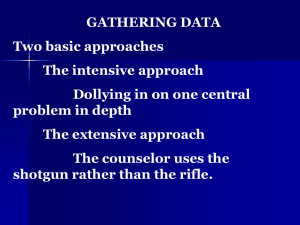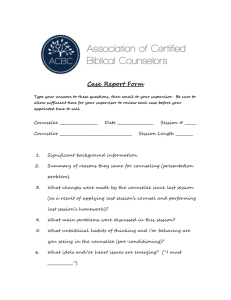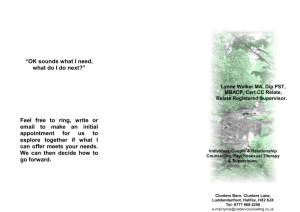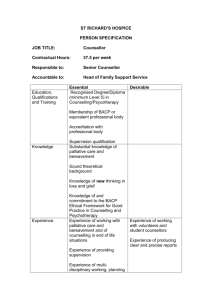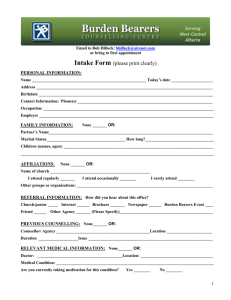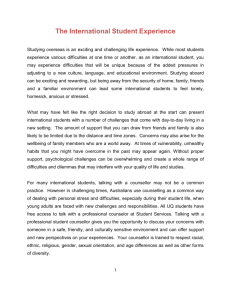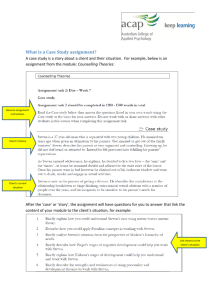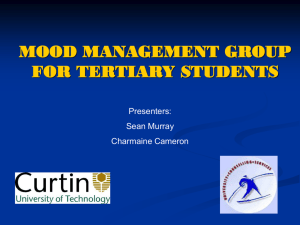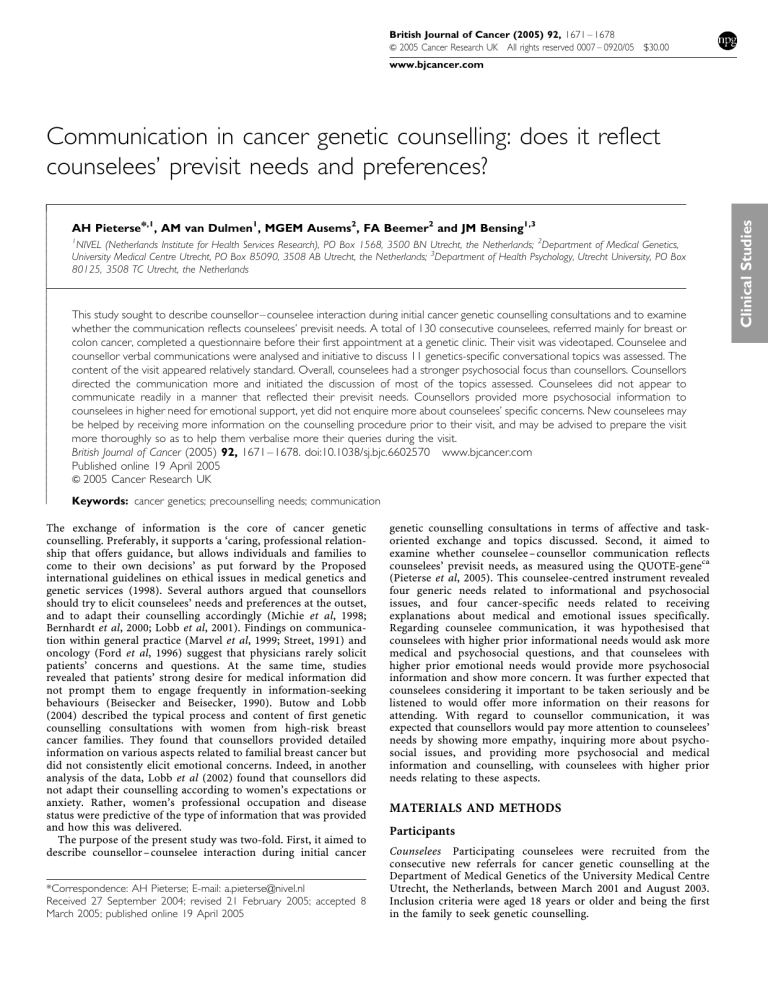
British Journal of Cancer (2005) 92, 1671 – 1678
& 2005 Cancer Research UK All rights reserved 0007 – 0920/05 $30.00
www.bjcancer.com
AH Pieterse*,1, AM van Dulmen1, MGEM Ausems2, FA Beemer2 and JM Bensing1,3
1
NIVEL (Netherlands Institute for Health Services Research), PO Box 1568, 3500 BN Utrecht, the Netherlands; 2Department of Medical Genetics,
University Medical Centre Utrecht, PO Box 85090, 3508 AB Utrecht, the Netherlands; 3Department of Health Psychology, Utrecht University, PO Box
80125, 3508 TC Utrecht, the Netherlands
This study sought to describe counsellor – counselee interaction during initial cancer genetic counselling consultations and to examine
whether the communication reflects counselees’ previsit needs. A total of 130 consecutive counselees, referred mainly for breast or
colon cancer, completed a questionnaire before their first appointment at a genetic clinic. Their visit was videotaped. Counselee and
counsellor verbal communications were analysed and initiative to discuss 11 genetics-specific conversational topics was assessed. The
content of the visit appeared relatively standard. Overall, counselees had a stronger psychosocial focus than counsellors. Counsellors
directed the communication more and initiated the discussion of most of the topics assessed. Counselees did not appear to
communicate readily in a manner that reflected their previsit needs. Counsellors provided more psychosocial information to
counselees in higher need for emotional support, yet did not enquire more about counselees’ specific concerns. New counselees may
be helped by receiving more information on the counselling procedure prior to their visit, and may be advised to prepare the visit
more thoroughly so as to help them verbalise more their queries during the visit.
British Journal of Cancer (2005) 92, 1671 – 1678. doi:10.1038/sj.bjc.6602570 www.bjcancer.com
Published online 19 April 2005
& 2005 Cancer Research UK
Keywords: cancer genetics; precounselling needs; communication
The exchange of information is the core of cancer genetic
counselling. Preferably, it supports a ‘caring, professional relationship that offers guidance, but allows individuals and families to
come to their own decisions’ as put forward by the Proposed
international guidelines on ethical issues in medical genetics and
genetic services (1998). Several authors argued that counsellors
should try to elicit counselees’ needs and preferences at the outset,
and to adapt their counselling accordingly (Michie et al, 1998;
Bernhardt et al, 2000; Lobb et al, 2001). Findings on communication within general practice (Marvel et al, 1999; Street, 1991) and
oncology (Ford et al, 1996) suggest that physicians rarely solicit
patients’ concerns and questions. At the same time, studies
revealed that patients’ strong desire for medical information did
not prompt them to engage frequently in information-seeking
behaviours (Beisecker and Beisecker, 1990). Butow and Lobb
(2004) described the typical process and content of first genetic
counselling consultations with women from high-risk breast
cancer families. They found that counsellors provided detailed
information on various aspects related to familial breast cancer but
did not consistently elicit emotional concerns. Indeed, in another
analysis of the data, Lobb et al (2002) found that counsellors did
not adapt their counselling according to women’s expectations or
anxiety. Rather, women’s professional occupation and disease
status were predictive of the type of information that was provided
and how this was delivered.
The purpose of the present study was two-fold. First, it aimed to
describe counsellor – counselee interaction during initial cancer
*Correspondence: AH Pieterse; E-mail: a.pieterse@nivel.nl
Received 27 September 2004; revised 21 February 2005; accepted 8
March 2005; published online 19 April 2005
genetic counselling consultations in terms of affective and taskoriented exchange and topics discussed. Second, it aimed to
examine whether counselee – counsellor communication reflects
counselees’ previsit needs, as measured using the QUOTE-geneca
(Pieterse et al, 2005). This counselee-centred instrument revealed
four generic needs related to informational and psychosocial
issues, and four cancer-specific needs related to receiving
explanations about medical and emotional issues specifically.
Regarding counselee communication, it was hypothesised that
counselees with higher prior informational needs would ask more
medical and psychosocial questions, and that counselees with
higher prior emotional needs would provide more psychosocial
information and show more concern. It was further expected that
counselees considering it important to be taken seriously and be
listened to would offer more information on their reasons for
attending. With regard to counsellor communication, it was
expected that counsellors would pay more attention to counselees’
needs by showing more empathy, inquiring more about psychosocial issues, and providing more psychosocial and medical
information and counselling, with counselees with higher prior
needs relating to these aspects.
MATERIALS AND METHODS
Participants
Counselees Participating counselees were recruited from the
consecutive new referrals for cancer genetic counselling at the
Department of Medical Genetics of the University Medical Centre
Utrecht, the Netherlands, between March 2001 and August 2003.
Inclusion criteria were aged 18 years or older and being the first
in the family to seek genetic counselling.
Clinical Studies
Communication in cancer genetic counselling: does it reflect
counselees’ previsit needs and preferences?
Counselee needs and communication in cancer genetics
AH Pieterse et al
1672
Counsellors All clinical geneticists, residents in clinical genetics
(of whom two finished their training during the study period), and
genetic nurses (of whom four finished their training) providing
cancer genetic counselling agreed to participate in the study. All
will be referred to as ‘counsellor’.
Procedure
Clinical Studies
The Medical Ethical Committee of the university hospital granted
permission to conduct the study, including videorecording of the
consultations. Participants were sent a questionnaire within a week
before their first consultation and were asked to complete it before
their visit at the clinic, along with an informed consent form. At
the start of the consultation, after collecting the questionnaire and
the signed informed consent form, the counsellor notified the
counselee about the fact that the video had started recording. The
unmanned camera was positioned to show the counsellor’s full
face; counselees were seen from behind or from the side. During
the visits conducted by counsellors in training, a clinical geneticist
was also present. Depending on the available medical information
and whether or not a DNA test is conducted, counselees have one
or multiple visits. In this paper, the communication process during
the initial visit is studied, as for a number of counselees it is the
only encounter with the counsellor and for all, during this
consultation the foundation for their relationship is laid.
Measures
The questionnaire contained items assessing counselees’ gender,
age, education, type of cancer for which they were seeking
counselling, and number of affected first- and second-degree
relatives. Information on counselee disease status and total
number of counselling visits was collected from their medical file.
At the start of their participation in the study, the counsellors’
gender, age, and profession were assessed.
Measurement of preferences: QUOTE-geneca As described elsewhere (Pieterse et al, 2005), a counselee-centred instrument was
developed for measuring importance attached to previsit needs
and preferences. It contains 25 generic items that relate to what
a counselee expects a counsellor to do during counselling, and 19
cancer-specific items that relate to receiving explanations on
hereditary cancer in particular. Response options to the individual
items were 1 ‘not important’ to 4 ‘extremely important’. Using
principal component analysis with varimax rotation, four generic
needs were identified: (a) procedural aspects of counselling (eight
items, Cronbach’s a ¼ 0.84), including what to expect from
counselling, (b) counsellor’s sensitive communication (eight items,
a ¼ 0.84), including being taken seriously and be listened to
carefully, (c) emotional support (five items, a ¼ 0.81), and (d)
assessment of susceptibility to the disease (three items, a ¼ 0.63)
(one item was left out as it loaded equally on two dimensions).
Similarly, four cancer-specific needs were identified: (a) determination and meaning of carrying a cancer gene (seven items,
a ¼ 0.82), mainly relating to possibilities and limitations of DNA
testing, (b) (emotional) aspects of counselling for counselee and
family (five items, a ¼ 0.76), (c) counselee’s own risk of developing
cancer (three items, a ¼ 0.80), and (d) heredity of cancer in general
(three items, a ¼ 0.76) (one item was left out as it loaded below
0.40 on any dimension). Importance scores on each issue were
computed as the mean score on the relevant items (range score
1 – 4).
Coding instruments
Communicative behaviours were rated through the use of an
adapted version of the Roter Interaction Analysis System (RIAS),
a widely used observation system for coding both physician and
British Journal of Cancer (2005) 92(9), 1671 – 1678
patient communication (Roter and Larson, 2002). The system
distinguishes mutually exclusive and exhaustive categories into
which verbal utterances that convey a complete thought can be
classified. A distinction is made between affective or socioemotional categories, and instrumental or task-oriented categories
(Appendix A1). Affective categories carry explicit emotional
content and refer to aspects of communication that are needed
to establish a therapeutically effective relationship. Task-oriented
categories refer to utterances that primarily focus on addressing
patients’ biomedical or psychosocial problems. Coded elements
can be used in analyses separately, or can be grouped into larger
conceptual composites. The adaptation of the coding system in this
study consisted of the elaboration of categories for coding the
exchange of pedigree data, medical information about relatives,
communication within the family, and agenda, that is, all
knowledge and questions that delineate what the interactants
bring to the encounter and/or express they had planned to discuss
during the visit.
Additionally, the following three measures were assessed: length
of the visit; counselees’ and counsellors’ contribution to the
encounter relative to the total count of utterances, as a measure of
participation in the consultation; and counselees’ and counsellors’
psychosocial focus, that is, the ratio of psychosocial/biomedical
questions and information (and education, for counsellors).
Moreover, a checklist was designed to assess whether or not
11 specific topics were discussed during the visit, and if it was
the counsellor’s initiative. Topics assessed were selected by expert
opinion for their relevance. Topics believed to be standard to
counselling were excluded, such as pedigree and (family) history of
cancer. Topics related to reasons for encounter, predisposition to
cancer, and DNA testing.
Coding reliability
Four coders were trained. The main coder coded 101 (54%) of all
consultations. Intra- and intercoder reliability were computed for
counsellor and counselee categories with mean occurrence greater
than 2% (Roter et al, 1991) and proved to be adequate. The main
coder recoded a random 10% of her own consultations and
reliability coefficients (Pearson’s r) for counsellor categories
averaged 0.81 (range, 0.54 – 0.96) and counselee categories
averaged 0.91 (range, 0.75 – 0.97). The other coders recoded a
random 10% of the main coder’s consultations. Intercoder
reliability for counsellor categories averaged 0.78 (range, 0.54 –
0.98) and counselee categories averaged 0.83 (range, 0.59 – 0.97).
Average intercoder reliability over the topics (Cohen’s k) was 0.69.
Statistical analyses
Frequencies of discussing and initiating topics were calculated and
whether these varied according to indication for DNA testing and
course of counselling (in total one vs multiple visits) was tested
using w2 or Fisher’s exact tests, as appropriate.
For analysing the influence of previsit needs on communication
behaviours, frequencies of counsellor and counselee utterances
were calculated. If two counsellors were present, their utterances
were added. Utterances of individuals accompanying counselees
are shown, yet were further left out of the analyses as the focus of
this paper was on counselees and their previsit needs. Verbal
coding categories, where relevant, were combined on the basis of
their content (Appendix A1) in line with the hypotheses. As several
encounters per counsellor were videotaped, to take account of the
resemblance among encounters for one counsellor, multilevel
regression analysis was used.
Multilevel regression analyses were carried out for counsellor
and counselee communication categories separately and in two
steps. First, background variables at counselee level (gender, age,
education, and personal and family history of cancer) and
& 2005 Cancer Research UK
Counselee needs and communication in cancer genetics
AH Pieterse et al
Communication behaviour
Counselee
Expression of concern
Medical questions
CE previsit need
Emotional support
Explanations on procedural aspects of
counselling
Explanations on the assessment of cancer
susceptibility
Explanations on the determination/meaning
of carrying a cancer gene
Explanations on CE own risk of cancer
Explanations on heredity of cancer
Explanations on (emotional) aspects of
counselling for CE/relatives
Emotional support
CR sensitive communication
Psychosocial questions
Psychosocial information
Information on agenda
Counsellor
Expression of empathy
Medical information/education
Psychosocial questions
Psychosocial information/
education
Emotional support
Explanations on procedural aspects of
counselling
Explanations on the assessment of cancer
susceptibility
Explanations on the determination/meaning
of carrying a cancer gene
Explanations on CE own risk of cancer
Explanations on heredity of cancer
Emotional support
Emotional support
Explanations on (emotional) aspects of
counselling for CE/relatives
Explanations on procedural aspects of
counselling
Education on agenda
counsellor level (gender, age, and profession) were included.
Where two participants were seen together by a counsellor,
counselee data were used for one (randomly selected) counselee
only. If two counsellors were present, characteristics of the
counsellor with the largest amount of utterances during the visit
were used. The categories ‘clinical geneticist’ and ‘resident’ were
aggregated into ‘doctor’ as opposed to ‘nurse’. Only significant
background correlates were retained. Second, (all) the previsit
need(s) was included in the model as hypothesised (Table 1). In
the Results section, only data on significant associations will be
presented.
Predictors at interval level measurement were recoded to
standardised z-scores. If 25% or less of the values were missing
on the QUOTE-geneca subscales, missing values were replaced by
the mean. Significance of the regression coefficients was tested
using w2 tests. Analyses were carried out using SPSS 11.5 and
MLwiN 1.10. Significance testing was carried out two-sided at
a ¼ 0.05 level.
RESULTS
Participants
Counselees Data at baseline and a videotape recording of
the initial visit were available for analysis for 130 counselees
(Figure 1).
In Table 2, relevant counselee characteristics are listed. The
counselees with a family history of cancer had one to four
(M ¼ 1.5, s.d. ¼ 0.8) first-degree and one to eight (M ¼ 2.1,
s.d. ¼ 1.5) second-degree affected relatives. Participants were, on
average, 2.1 years older than decliners (P ¼ 0.022) (Pieterse et al,
2005); however they did not differ in gender, referral pathway, type
of cancer, or (family) history of cancer.
622 consecutive counselees
were approached
418/622 (67%)
declined participation
204/622 (33%)
agreed to participate
For 4/204 (2%),
no questionnaire data available
For 200/204 (98%)
questionnaire data available
For 14/200 (7%),
no recording of initial visit available
For 186/200 (93%)
usable videotape recording
of initial visit available
Reasons: technical or logistic failure (5 times); recording
inadvertently not started (5); two participating counselees
were seen together (3); too many individuals present for
allowing correct identification of whom was talking (1)
56 consultations were conducted by a counsellor
who received a communication feedback training
and were left out of the analyses
130 visits were used for assessing
communication during initial cancer
genetic counselling visits
Figure 1 Details of inclusion of counselees.
& 2005 Cancer Research UK
British Journal of Cancer (2005) 92(9), 1671 – 1678
Clinical Studies
1673
Table 1 Hypothesised positive associations between counselee (CE)
and counsellor (CR) communication, and CE previsit need(s)
Counselee needs and communication in cancer genetics
AH Pieterse et al
1674
Table 2 Counselee demographics, history of cancer, and course of
counselling
N
Age (years)
Mean (s.d.)
Range
Gender
Female
Male
%
44.5 (9.4)
18 – 72
Clinical Studies
122
8
94
6
Education
High school level
Secondary level
58
72
45
55
Type of cancer
Breast cancer
Colon cancer
Breast and colon cancer
Ovarian cancer
Other cancers
83
25
9
8
5
64
19
7
6
4
Personal history of cancer
Counselee affected with cancer
Counselee unaffected with cancer
63
67
49
52
114
12
91
10
Family history of cancer
First- or second-degree relatives affected with cancer
No first- or second-degree relatives affected with cancer
Indication for DNA testinga
Yes
No
Unclearb
86
21
23
66
16
18
Total number of visits
1
2 or more
44
86
34
66
Summations vary because of missing data. aIndication for testing the counselee or a
relative as judged after the initial visit. bIndication for DNA testing unclear due to
missing medical information.
Counsellors Five clinical geneticists (four female, one male), four
residents in clinical genetics (three female, one male), and five
genetic nurses (all female) participated. Counsellors were aged
29 – 46 years (M ¼ 38.1, s.d. ¼ 5.3).
Consultations Consultations lasted 43.9 min (s.d. ¼ 13.7) on
average. The counsellors conducted 93 visits out of 130 (72%)
alone. During the 37 visits out of 130 that were conducted by a
clinical geneticist together with a resident or a nurse, the
counsellor with the largest amount of utterances averaged 468.4
statements (s.d. ¼ 162.9; min. ¼ 199, max. ¼ 821), compared to a
mean of 138.5 utterances by the other counsellor (s.d. ¼ 85.5;
min. ¼ 6, max. ¼ 369). Moreover, in 29 (78%) of these 37 visits, the
former spoke at least two times more than the latter. In 63 of the
130 (48%) visits, counselees were seen alone. During all other
consultations, counselees were accompanied by one (N ¼ 61) or
two or more individuals (N ¼ 6). Utterances of companions added
up to 6.7% of the total communication (Table 3).
Task-oriented communication consisted largely of counselees
providing information (17.5%) and counsellors informing and
educating counselees (21.0%). The counselees mainly provided
information on their family history of cancer, medical condition,
and pedigree, adding up to 26% of counselee talk (not in the table).
They further essentially provided information on their agenda and
on psychosocial issues, each category adding up to 6% of counselee
talk. The counsellors asked counselees about their agenda in 123 of
the 130 visits and the counselees provided information on their
agenda in 129 of the 130 visits. The counsellors mostly provided
information on general or counselee-related medical issues, as well
as medical advices for counselees and their relatives, utterances
that amounted to 33% of counsellor talk (not in the table).
The counselees contributed significantly less to the interaction
than the counsellors, a mean of 40 vs 53% utterances (paired
t ¼ 11.8, P ¼ 0.000). In particular, counsellors asked significantly
more questions (3.7 vs 0.6%; paired t ¼ 17.45, P ¼ 0.000) and made
significantly more orienting or directive remarks (5.8 vs 1.0%;
paired t ¼ 19.84, P ¼ 0.000). The counsellors also used significantly
more paraphrases (7.9 vs 2.1%; paired t ¼ 19.47, P ¼ 0.000),
thereby confirming shared understanding and knowledge. This
included summaries of family history of cancer, information that
the counsellor gathered from the counselee prior to or during the
visit. The counselees had a significantly stronger psychosocial
focus than counsellors (paired t ¼ 10.57, P ¼ 0.000).
Topics covered during the visit
Overall, the counselees’ motives for and referral pathway to
counselling were almost always a topic of discussion, in contrast to
their risk perceptions (Table 4).
Also, predisposition to cancer and possibilities, limitations, and
procedure of DNA testing were discussed in a majority of visits.
Medical consequences of testing were discussed in more than half
and emotional consequences in less than half of the visits. In 79 –
99% of the visits, the counsellor initiated the discussion of a topic,
except for emotional consequences of DNA testing, where
counsellors took the initiative in just over half (31 out of 53;
59%) of the visits in which it was discussed (not in the table).
Indication for DNA testing and whether the initial visit would
be the only one or not did not affect the frequency of discussing
reasons for encounter. With counselees for whom DNA testing was
indicated, mode of inheritance and meaning of genetic predisposition were discussed significantly more often compared to
those without an indication (P ¼ 0.015 and 0.040, respectively), as
well as possibilities (P ¼ 0.001), procedure (P ¼ 0.000), and medical
consequences of testing (P ¼ 0.043). Compared to those who would
be seen again, how often the type of cancer is genetic and
procedure of DNA testing were discussed less often with
counselees for whom the initial visit was the only visit (P ¼ 0.009
and 0.001, respectively).
Influence of previsit needs on counselee communication
Previsit needs slightly affected counselee communication in that
there was a trend for counselees considering it more important to
receive explanations on the assessment of cancer susceptibility to
ask more medical questions (B ¼ 0.20, w2 ¼ 3.74, P ¼ 0.053) and
those attaching more weight to be taken seriously and be listened
to carefully, to provide more information on their agenda
(B ¼ 0.14, w2 ¼ 2.98, P ¼ 0.084).
Influence of previsit needs on counsellor communication
Counselee and counsellor conversational contribution
On average, 19% of counselee and 14% of counsellor communication related to socio-emotional communication, mainly (16.8. vs
11.4%) indications of acknowledgment or agreement (Table 3).
British Journal of Cancer (2005) 92(9), 1671 – 1678
The counselees’ previsit needs affected counsellor communication
in that counsellors provided more psychosocial information and
education to counselees who had higher previsit needs for
emotional support (B ¼ 0.21, w2 ¼ 4.29, P ¼ 0.038).
& 2005 Cancer Research UK
Counselee needs and communication in cancer genetics
AH Pieterse et al
1675
Mean and percentagea of occurrence of the various coding categories (N ¼ 130 visits)
Counsellor(s)
Other(s)b
Counselee
M
s.d.
%
M
s.d.
%
M
s.d.
%
22.6
128.4
0.1
3.7
1.2
1.1
157.1
19.2
64.7
0.5
3.4
2.0
1.6
69.7
2.1
11.4
0.0
0.4
0.1
0.1
14.1
18.8
183.8
0.8
—
0.1
3.0
206.5
12.9
88.8
1.4
—
0.4
2.9
92.4
1.7
16.8
0.1
—
0.0
0.3
18.9
6.5
30.2
0.1
—
0.0
0.6
37.5
14.7
50.3
0.6
—
0.2
1.5
62.1
0.5
2.5
0.0
—
0.0
0.0
3.0
Task-oriented communication
Orientation
60.1
31.4
5.8
10.3
7.6
1.0
2.4
5.7
0.2
Partnership building behaviour
Clarification
Paraphrase
Opinion
Total
1.7
83.2
1.4
86.3
3.2
33.2
11.0
35.6
0.2
7.9
0.1
8.2
0.6
23.8
0.1
24.4
0.9
19.7
0.3
19.8
0.1
2.1
0.0
2.2
0.1
6.4
0.0
6.5
0.5
10.4
0.1
10.7
0.0
0.6
0.0
0.6
Questions
Medical condition, counselee
Screening/prophylactic surgery, counselee
Medical condition, relative(s)
Pedigree data
Communication within family
Lifestyle
Agenda
Psychosocial issues
Current feelings
Total
3.6
1.2
16.6
7.9
1.0
0.6
3.9
2.4
0.0
37.2
3.6
2.1
10.5
7.6
1.4
1.4
2.7
2.4
0.2
18.7
0.3
0.1
1.6
0.8
0.1
0.1
0.4
0.2
0.0
3.7
4.7
0.6
1.0
0.2
0.1
0.1
0.0
0.1
0.2
6.9
5.5
1.4
1.4
0.6
0.3
0.3
0.0
0.4
0.6
7.1
0.4
0.1
0.1
0.0
0.0
0.0
0.0
0.0
0.0
0.6
1.6
0.1
0.4
0.1
0.0
0.0
0.1
0.1
0.0
2.5
3.2
0.5
1.1
0.7
0.1
0.2
0.4
0.4
0.0
4.7
0.1
0.0
0.0
0.0
0.0
0.0
0.0
0.0
0.0
0.2
Information
Medical condition, counselee
Screening/prophylactic surgery, counselee
Medical condition, relative(s)
Pedigree data
Communication within family
Lifestyle
Agenda
Psychosocial issues
Current feelings
Total
139.2
9.4
6.9
0.7
0.4
0.6
3.0
3.1
0.2
163.6
68.7
13.4
8.1
1.3
0.8
1.8
2.9
5.0
0.5
78.1
12.8
0.8
0.7
0.1
0.0
0.1
0.3
0.3
0.0
15.1
27.7
6.1
62.7
22.7
7.3
7.2
26.2
30.4
1.5
191.8
28.2
7.8
38.1
17.0
6.8
10.8
16.9
28.2
2.3
90.1
2.4
0.5
6.0
2.2
0.7
0.6
2.4
2.6
0.1
17.5
4.1
0.6
11.3
3.6
0.8
1.1
3.7
5.3
0.3
30.8
9.6
2.0
24.8
9.7
2.1
3.1
8.4
11.9
2.1
58.7
0.3
0.0
1.0
0.3
0.1
0.1
0.3
0.4
0.0
2.5
30.3
7.2
18.3
1.7
0.0
0.3
6.6
64.5
20.8
7.7
18.3
2.7
0.0
0.9
9.6
34.7
2.9
0.7
1.6
0.2
0.0
0.0
0.6
5.9
—
—
—
—
—
—
—
—
—
—
—
—
—
—
—
—
—
—
—
—
—
—
—
—
—
—
—
—
—
—
—
—
—
—
—
—
—
—
—
—
—
—
—
—
—
—
—
—
Other utterances
1.1
1.7
0.1
1.9
2.5
0.2
1.2
2.6
0.1
Additional measures
Psychosocial focus
Conversational contribution
0.0
0.0
0.3
0.3
Socio-emotional communication
Social talk
Agreement
Concern
Verbal attention
Reassurance
Disagreement
Total
Counselling
Cancer risk/DNA test, counselee
Screening/prophylactic surgery, counselee
Cancer risk/screening advice, relative(s)
Advice/request about family communication
Lifestyle
Education about agenda
Education about psychosocial issues
Total
52.9
40.5
—
6.7
Summations may vary due to rounding off. aPercentages were calculated with regard to the total amount of utterances of all participants in the encounter. bIndividuals
accompanying counselees; their utterances were not added to counselees’ in the analyses.
DISCUSSION
revealed that counselees’ previsit needs only slightly affected
counselee and counsellor communication behaviours.
In the present study, a detailed analysis of the interaction during
the initial cancer genetic counselling visit was carried out, and the
extent to which counselees’ previsit needs as measured with the
QUOTE-geneca are reflected in the communication was assessed. It
Course and content of the interaction
& 2005 Cancer Research UK
The results show that on average counsellors contribute more to
the interaction than do counselees, in agreement with Butow and
British Journal of Cancer (2005) 92(9), 1671 – 1678
Clinical Studies
Table 3
Counselee needs and communication in cancer genetics
AH Pieterse et al
1676
Table 4
Frequencies (%) of discussing topics during the initial visit
Indication for DNA testa
Overall (N ¼ 130)
No (N ¼ 21)
Reason for encounter
Motive for counselling
Referral pathway
Counselee risk perceptions
93.0
88.3
14.6
90.0
90.5
23.8
94.2
86.9
15.1
93.0
90.7
13.6
93.0
87.1
15.1
Predisposition to cancer
Mode of inheritance
Prevalence of hereditary type of cancer
Meaning of genetic predisposition
80.0
80.8
77.5
66.7
76.2
66.7
89.5*
83.7
88.2*
72.7
68.2
69.8
83.7
87.2**
81.4
DNA testing
Possibilities
Limitations
Procedure
Medical consequences
Emotional consequences
88.4
82.3
76.0
60.8
40.8
71.4
76.2
23.8
47.6
28.6
97.7**
89.5
94.2***
70.9*
48.8
86.0
84.1
58.1
52.3
38.6
89.5
81.4
84.9**
65.1
41.9
Topic
Yes (N ¼ 86)
Total number of visits
1 (N ¼ 44)
2 or more (N ¼ 86)
Clinical Studies
a
Totals do not add up to 130 because indication for DNA testing was unclear after the initial visit for 23 out of 130 counselees. *Po0.05; **Po0.01; ***Po0.001.
Lobb (2004). The proportion of socio-emotional talk was
analogous to other secondary care settings (15% for specialist
and 21% for patient) (Van Dulmen, 1999). Counsellors directed the
communication more than did counselees, partly by using
orienting utterances, a structuring behaviour that is seen as part
of basic medical tasks (Roter, 2000). They also asked more
questions than counselees, and these concerned three times more
often biomedical than psychosocial issues. This finding is not
surprising, as primarily the likelihood that cancer running in the
family is genetic needs to be estimated, and that counselees do not
always provide sufficient (family) medical and pedigree information prior to the encounter. The counsellors also directed the
interaction more by initiating the discussion of the medical topics
assessed, in a large majority of the visits.
In almost all visits, the counselees’ agenda was discussed, and
counsellors asked about it in a higher proportion of visits than
Butow and Lobb (2004) found (i.e., in 123 out of 130 or 95%
compared to 69%). It is unknown in how far counselees’ agenda
was followed. The counselees were found to ask relatively few
questions compared to counsellors and to spend only a mean of
0.6/40.4, that is, 2% of their utterances, in asking questions
(Table 3). As Butow and Lobb (2004) noted, passive listening
reduces understanding and especially where substantial amounts
of new information are presented, a more interactive discussion
might increase counselees’ understanding and recall. Low patient
question-asking behaviour was noted by various authors in other
medical settings (Beisecker and Beisecker, 1990; Street, 1991; Ford
et al, 1996). As patient question-asking was found to be strongly
related to physicians’ provision of medical information (Street,
1991; Butow et al, 1995), counselees might moreover elicit more
effective responses from counsellors if they would make more use
of this directing tool. Low question-asking may be related to
counselee concession to expert authority, or to unfamiliarity with
the content and process of cancer genetic counselling (Collins et al,
2000), or the exact role of counsellors in the provision of health
care (Bernhardt et al, 2000). Hallowell et al (1997) found that
unfamiliarity with cancer genetic counselling inhibited counselees
to formulate questions in advance, and that a large minority
envisaged their role as passive. Limited question-asking behaviour
might also result from counselees having gathered ample
information about hereditary cancer, screening, and risk management before their visit. The information counsellors subsequently
provide may then be relatively easy to understand. However,
results showing counselees’ disappointment about the amount of
British Journal of Cancer (2005) 92(9), 1671 – 1678
information received during counselling (Hallowell et al, 1997) and
high expectations of having a DNA test carried out (Pieterse et al,
2005) while the availability of this option is limited, contradict this
proposition. It is conceivable that the large amount of information
conveyed during the visit at the counsellors’ initiative may not
only have answered at least partly counselees’ questions, but may
also require time for counselees to sink in.
Moreover, the interaction was mainly focused around biomedical
issues. It is remarkable that potential emotional consequences of
DNA testing were discussed with less than half of counselees who had
an indication for testing, for themselves or a relative. Even counselees
who have thought through the option and clearly state they want a test
might overlook how this decision or the test result may emotionally
disturb themselves or their family. It would seem appropriate to
discuss this topic with counselees who have an indication, before
DNA testing is started. Counselees had a stronger psychosocial focus
than counsellors, as was also illustrated by them initiating more often
the discussion of emotional consequences of DNA testing, compared
to the other topics assessed. Apparently, psychosocial issues are rather
on counselees’ than on counsellors’ agenda. Alternatively, counselees
may have felt invited to bring forward socio-emotional issues, for
instance by counsellors’ eye gaze. This was found to be a powerful
instrument for doctors to detect potential psychosocial problems
in patients (Bensing et al, 1995). Post hoc testing showed that the
amount of counsellor eye gaze was significantly related to the amount
of psychosocial information counselees provided.
Compared to the other topics assessed, risk perception appears
not to be a major subject during the initial visit. Where counselling
is continued, actual risk may often not yet be clear at this stage;
thus, discussing risk perceptions may be postponed. However,
even with counselees seen at the clinic only once, their risk
perceptions were not examined against actual risks as could be
best established at the time. Studies showed that after counselling,
risk perceptions were reduced compared to baseline; nonetheless,
inaccuracies persisted (Cull et al, 1999; Collins et al, 2000; Lobb
et al, 2003). Probing these perceptions and discussing them where
they greatly deviate from the counsellor’s estimation may improve
accuracy. Topics relating to predisposition to cancer and DNA
testing were increasingly often discussed with counselees for whom
it appears more relevant. However, all medical topics except
procedure and medical consequences of testing were discussed
with two-thirds or more of all counselees, exemplifying the large
amount of medical information that is conveyed nearly standard
during counselling.
& 2005 Cancer Research UK
Counselee needs and communication in cancer genetics
AH Pieterse et al
1677
Results suggest that counselees’ previsit needs minimally influence
the interaction during the initial visit and counselees did not
appear to tailor their verbal communication to their previsit needs.
This apparent reluctance to explicitly ask for desired information
(Roter, 1977; Street, 1991) or to express directly emotional
concerns (Street, 1991; Suchman et al, 1997), was noted earlier
in primary care patients.
Counsellors appeared sensitive to counselees’ needs for emotional support, although not by questioning them more about their
concerns, replicating the finding by Butow and Lobb (2004).
Counselees may be reluctant to mention emotional issues, due to
psychological embarrassment or hesitation to trouble the counsellor, or possibly because they feel deterred by counsellor’s
interview behaviours as was found in primary care (Cape and
McCulloch, 1999). It may be advisable to counsellors to invite the
discussion of psychosocial issues so as to assess whether
counselees have questions or whether they desire to share their
concerns, and to be able to respond more adequately to counseleespecific issues.
Limitations
First, the response rate of counselees was low. It may have been
due to procedural requirements for indicating interest, as
increased study requirements (Helmes et al, 2000; Friebel et al,
2004) and understanding written information (Cox, 2002; Friebel
et al, 2004) may discourage participation. Furthermore, as the
counsellor was unknown to eligible counselees at the time and was
not involved in the recruitment, low participation may also have
resulted from the lack of a ‘trusted source’ that explicitly
recommended participation (Kreiger et al, 2001). Additionally,
videotaping may have adversely affected willingness to participate.
Findings from Howe (1997) suggest that patient refusal to have
their primary care consultation videotaped may be associated with
complex contextual and socio-demographic factors, and with
decreasing age in particular. In our study, participants indeed were
older than decliners; however, they did not differ on other
background measures (Pieterse et al, 2005). It is unknown whether
participants and decliners differed on their needs, and thus how
representative our sample is for the larger population. Also, 94% of
participating counselees were female, half (55%) of the counselees
were higher educated, and a majority (64%) sought counselling for
hereditary breast cancer. The results should therefore only be
generalised with caution to men, to the broader population of, on
average, lower educated women at increased risk of developing
hereditary cancer, and to other types of hereditary cancers than
breast cancer.
Second, we did not record counsellor – counselee phone or mail
contacts, so we cannot exclude with certainty that topics that were
not discussed during initial visits at the clinic were actually not
discussed with counselees who were seen once only.
Third, a stronger association between verbal communication
and counselee previsit needs may be found using an interaction
coding instrument that is specifically designed to code for the
needs that were measured using the QUOTE-geneca.
CONCLUSION
Counsellors appear to dominate initial cancer genetic counselling
visits, while counselees play a more passive role in the interaction
than one might expect, given that genetic counselling is rather a
medical possibility than a necessity. Results suggest counselees to
have a stronger psychosocial agenda compared to counsellors;
however, they may not be sufficiently acquainted with this
specialist health service to come well prepared and take a more
active role in the encounter. Counsellors appear to tailor their
communication to counselees’ emotional needs, however not by
enquiring more about psychosocial issues or showing more
empathy. Neither do counsellors adapt their communication to
counselees’ informational previsit needs. Yet, counselees do not
appear to readily verbalise their prior needs. Newly referred
counselees may be helped by receiving more information on the
counselling procedure prior to the consultation, and they may be
advised on how to prepare their visit. They may, for example, be
encouraged to write down questions in advance, possibly helped
by a prompt sheet such as was successfully devised for promoting
cancer patients’ participation (Brown et al, 1999; Wells et al, 2004),
or to send questions ahead to the counsellor.
ACKNOWLEDGEMENTS
We thank the participating counselees and counsellors for their
efforts during the study period. We greatly appreciate the
contribution of Patricia Steffen in developing the questionnaire
and adapting the coding system. Finally, we thank Maaike
Beltman, Fred Tromp, and Monique Veldkamp for their help in
coding the videotapes. The study was supported by a grant from
the Dutch Cancer Society.
REFERENCES
Beisecker AE, Beisecker TD (1990) Patient information-seeking behaviors
when communicating with doctors. Med Care 28: 19 – 28
Bensing JM, Kerssens JJ, Pasch Mvd (1995) Patient-directed gaze as a tool
for discovering and handling psychosocial problems in general practice.
J Nonverbal Behav 19: 223 – 242
Bernhardt BA, Biesecker BB, Mastromarino CL (2000) Goals, benefits, and
outcomes of genetic counseling: client and genetic counselor assessment.
Am J Hum Genet 94: 189 – 197
Brown R, Butow PN, Boyer MJ, Tattersall MHN (1999) Promoting patient
participation in the cancer consultation: evaluation of a prompt sheet
and coaching in question-asking. Br J Cancer 80: 242 – 248
Butow P, Lobb E (2004) Analyzing the process and content of genetic
counseling in familial beast cancer consultations. J Genet Couns 13: 403 –
424
Butow PN, Dunn SM, Tattersall MH, Jones QJ (1995) Computer-based
interaction analysis of the cancer consultation. Br J Cancer 71: 1115 – 1121
Cape J, McCulloch Y (1999) Patients’ reasons for not presenting emotional
problems in general practice consultations. Br J Gen Pract 49: 875 – 879
& 2005 Cancer Research UK
Collins V, Halliday J, Warren R, Williamson R (2000) Assessment of
education and counselling offered by a familial colorectal cancer clinic.
Clin Genet 57: 48 – 55
Cox K (2002) Informed consent and decision-making: patients’ experiences
of the process of recruitment to phases I and II anti-cancer drug trials.
Patient Educ Couns 46: 31 – 38
Cull A, Anderson ED, Campbell S, Mackay J, Smyth E, Steel M (1999) The
impact of genetic counselling about breast cancer risk on women’s risk
perceptions and levels of distress. Br J Cancer 79: 501 – 508
Ford S, Fallowfield L, Lewis S (1996) Doctor – patient interactions in
oncology. Soc Sci Med 42: 1511 – 1519
Friebel TM, Beutler RA, Lee SM, Bernhardt BA, Helzlsouer KJ, Griffin CA
(2004) Active recruitment increased enrollment in a hereditary cancer
registry. J Clin Epidemiol 57: 1172 – 1176
Hallowell N, Murton F, Statham H, Green JM, Richards MPM (1997)
Women’s need for information before attending genetic counselling for
familial breast or ovarian cancer: a questionnaire, interview, and
observational study. BMJ 314: 281 – 283
British Journal of Cancer (2005) 92(9), 1671 – 1678
Clinical Studies
Influence of previsit needs on communication
Counselee needs and communication in cancer genetics
AH Pieterse et al
1678
Clinical Studies
Helmes AW, Bowen DJ, Bowden R, Bengel J (2000) Predictors of
participation in genetic research in a primary care physician network.
Cancer Epidemiol Biomarkers Prev 9: 1377 – 1379
Howe A (1997) Refusal of videorecording: what factors may influence
patient consent? Fam Pract 14: 233 – 237
Kreiger N, Ashbury F, Cotterchio M, Macey J (2001) A qualitative study of
subject recruitment for familial cancer research. Ann Epidemiol 11: 219 –
224
Lobb EA, Butow P, Meiser B, Tucker K, Barratt A (2001) How do geneticists
and genetic counselors counsel women from high-risk breast cancer
families? J Genet Couns 10: 185 – 199
Lobb EA, Butow PN, Meiser B, Barratt A, Gaff C, Young MA, Kirk J, Gattas
M, Gleeson M, Tucker K (2003) Women’s preferences and consultants’
communication of risk in consultations about familial breast cancer:
impact on patient outcomes. J Med Genet 40: e56
Lobb EA, Butow PN, Meiser B, Barratt A, Gaff C, Young MA, Kirk J, Suthers
GK, Tucker K (2002) Tailoring communication in consultations with
women from high risk breast cancer families. Br J Cancer 87: 502 – 508
Marvel MK, Epstein RM, Flowers K, Beckman HB (1999) Soliciting the
patient’s agenda: have we improved? JAMA 281: 283 – 287
Michie S, Weinman J, Marteau TM (1998) Genetic counselors’ judgments of
patient concerns: concordance and consequences. J Genet Couns 7: 219 –
231
Pieterse A, Van Dulmen S, Ausems M, Schoemaker A, Beemer F, Bensing J
(2005) QUOTE-geneca: development of a counselee-centered instrument
to measure needs and preferences in genetic counseling for hereditary
cancer. Psychooncology. Doi 10.1002/pon.853
Proposed international guidelines on ethical issues in medical genetics and
genetic services (Part II) (1998) World Health Organization, Human
genetics Programme. Law Hum Genome Rev 239 – 251
Roter D (2000) The enduring and evolving nature of the patient – physician
relationship. Patient Educ Couns 39: 5 – 15
Roter D, Larson S (2002) The Roter interaction analysis system (RIAS):
utility and flexibility for analysis of medical interactions. Patient Educ
Couns 46: 243 – 251
Roter D, Lipkin Jr M, Korsgaard A (1991) Sex differences in patients’ and
physicians’ communication during primary care medical visits. Med
Care 29: 1083 – 1093
Roter DL (1977) Patient participation in the patient – provider interaction:
the effects of patient question asking on the quality of interaction,
satisfaction and compliance. Health Educ Monogr 5: 281 – 315
Street RL (1991) Information-giving in medical consultations: the influence
of patients’ communicative styles and personal characteristics. Soc Sci
Med 32: 541 – 548
Suchman AL, Markakis K, Beckman HB, Frankel R (1997) A model of
empathic communication in the medical interview. JAMA 277: 678 – 682
Van Dulmen AM (1999) Communication during gynecological out-patient
encounters. J Psychosom Obstet Gynaecol 20: 119 – 126
Wells T, Falk S, Dieppe P (2004) The patients’ written word: a simple
communication aid. Patient Educ Couns 54: 197 – 200
Appendix A1
Counselee (CE) and counsellor (CR) individual coding categories
and combinations of these used in the analyses are given in
Table A1.
Table A1
Counselee (CE) and counsellor (CR) individual coding categories and combinations of these used in the analyses
Socio-emotional communication
Social talk
Personal remarks, social conversation, laughs, jokes, approval, compliments
Agreement
Signs of acknowledgement, agreement or understanding
Concerna
Immediate emotional or psychosocial worries, crying
Legitimise, empathy, partnership, support
Verbal attentiona,b
a
Reassurance
Give reassurance, ask for reassurance
Disagreement
Disapproval, criticism, disagree
Task-oriented communication
Orientation
Directive remarks regarding the course of the visit, division of roles between counsellors
Clarification
Bid for repetition, ask for understanding
Opinion
Ask for opinion, give opinion
Paraphrase
Checks for understanding, confirm shared understanding or knowledge
c
Medical questions
Questions that ask for information on medical condition or screening or prophylactic surgery
Nonmedical questions Questions that ask for information on pedigree, communication within family, lifestyle, agenda, psychosocial issues,d or current feelingsd
Medical informatione Statements or facts relating to medical condition or screening or prophylactic surgery
Nonmedical
Statements or facts relating to pedigree, communication within family, lifestyle, agenda, psychosocial issues,f,g or current feelingsf
information
Medical educationb,e Statements relating to risk of cancer or indication for DNA testing, or statements that suggest action to be taken by the other relating to
screening or prophylactic surgery
Statements which suggest resolution or action to be taken by the other relating to family communication, lifestyle, or psychosocial issues,g or
Psychosocial
b
statements aimed at education about psychosocial issuesg or agenda
education
Other
Other utterances, unintelligible utterances
a
Combined into CR empathy. bCR only. cGeneral medical information and medical information concerning CEs specifically were distinguished from medical information relating
to CEs’ relative(s). dCombined into CR psychosocial questions. eCombined into CR medical information and education. fCombined into CE psychosocial information. gCombined
into CR psychosocial information and education.
British Journal of Cancer (2005) 92(9), 1671 – 1678
& 2005 Cancer Research UK

